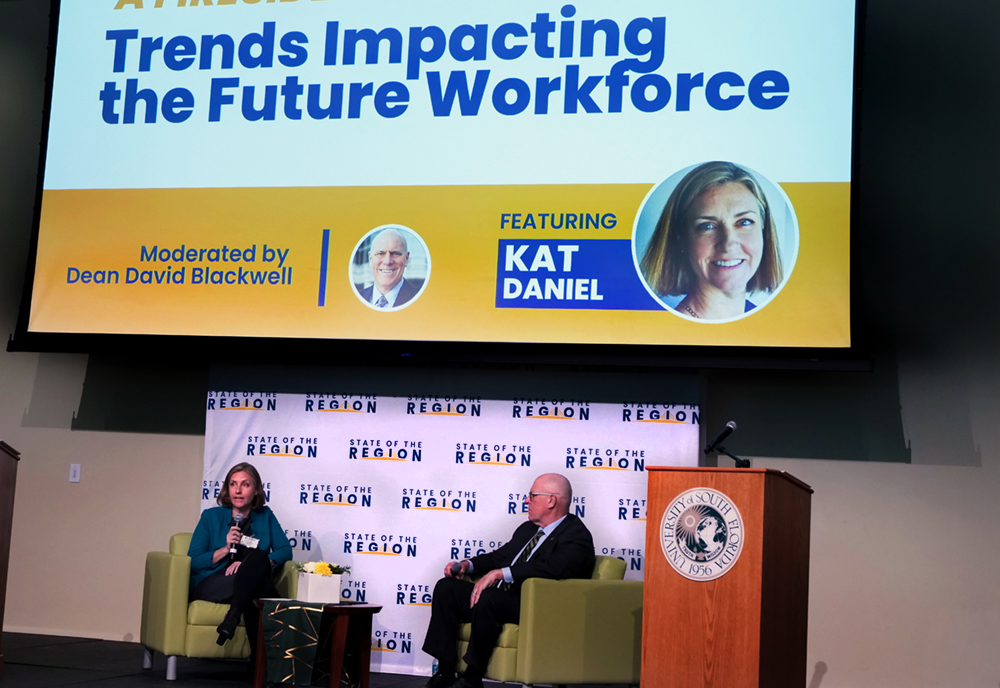TAMPA — People are still moving to the Tampa Bay region in droves. Residents find
paying for housing and transportation a tad easier. Our littlest tykes are more prepared
for kindergarten. And third-graders are making significant strides in reading — a
critical marker in primary education.
Even better news: over 7,000 more teens and young adults are enrolled in school or
working, climbing out of the ‘disconnected youth’ population.
These were the major trends revealed at the eighth ‘State of the Region’ community
luncheon held on Thursday in the Marshall Student Center ballroom on the Tampa campus
of the University of South Florida.
The USF Muma College of Business and the Tampa Bay Partnership partnered to publish
two complementary benchmarking reports — the 2025 Tampa Bay E-Insights Report and the 2025 Regional Competitiveness Report — which show how the region compares with 19 similar metropolitan communities.
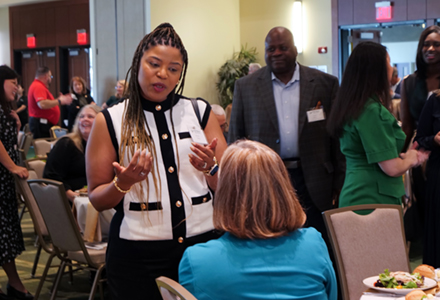
The publications also serve as a roadmap for local and state legislators, public and
private business leaders, and community organizers to improve the region’s economic
health and growth.
The reports showcase the latest regional strengths while also pin-pointing areas of
opportunity. Other notable takeaways include:
- Tampa Bay is No. 1 in attracting new residents, although at a slower rate over the previous year
- The regional population is becoming more educated, with increased educational attainment rates for two-year, four-year, and graduate degrees
- Kindergarten enrollment jumped 6.5% and third-grade reading levels improved by nearly 6%
Over 400 community organizers, business leaders and government officials gathered
for the annual event.
“We will take a deeper look into the talent continuum and explore how a strong educational
foundation can pave the way for a robust workforce and improved economic vitality
for the region,” said David Blackwell, Lynn Pippenger Dean at the Muma College of Business.
Blackwell, who brought props onto the stage, including a film slate and a bullhorn,
urged the audience to turn the data into action.
“Let’s learn together, lean in, and move this region forward,” he said. “Tell us which
parts of this report resonate with you, and think about which of these drivers you
can influence.”
Researchers with the USF Muma College of Business published the 2025 Tampa Bay E-Insights Report, a 68-page report that focuses on three main areas: economic outcomes, affordability,
and talent pipeline. The Tampa Bay Partnership, in collaboration with Community Foundation
Tampa Bay and United Way Suncoast, created the 2025 Regional Competitiveness Report.
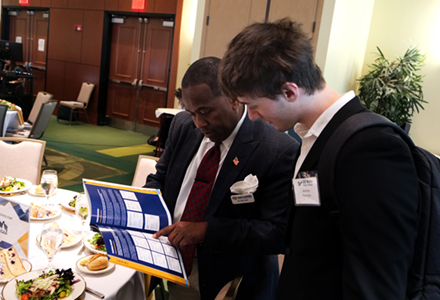
“Many of you in this room are not just talking about the problems, you are actively
driving solutions,” said Bemetra Simmons, president and CEO of Tampa Bay Partnership.
Overall, the partnership’s report shows that Tampa Bay has had a year-over-year improvement
in 43 of the 67 indicators and the region’s ranking improved in over a third of the
metrics tracked.
“I could not be more excited about the good news,” Simmons said. “As a community,
we have been wrapping our arms around early learning metrics and seeking pathways
to better serve our opportunity youth.”
During Thursday’s luncheon, researchers took turns highlighting specific data sets
and explained the trend lines as moderators held a “Fireside Chat” with Kat Daniel,
a senior consultant and workforce development expert for Bloomberg Associates.
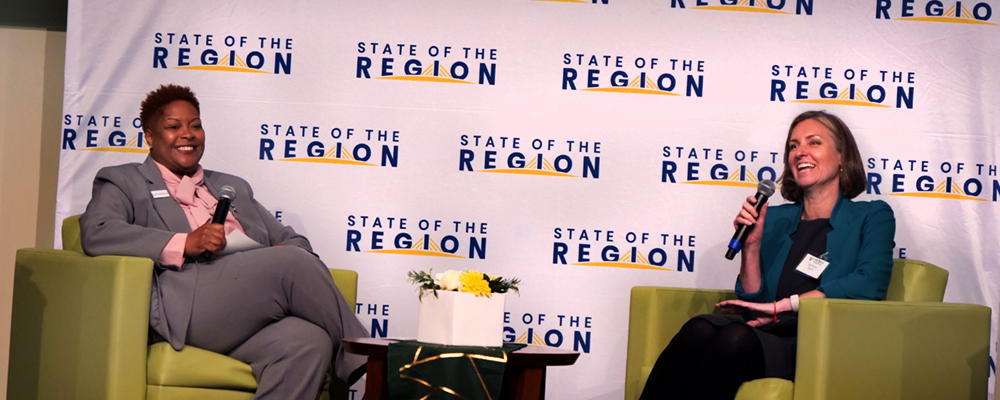
In one of Daniel’s sit-downs, she discussed the challenges of tomorrow’s workforce.
She said employers are looking to hire the perfect unicorn and leaving a lot of qualified
people on the table.
This disconnect between job opportunities and job candidates is a growing problem
and employers have to “normalize” that not every successful candidate needs a bachelor’s
degree, she said.
“We’re going to have to figure out how to close that labor market gap,” Daniel said.
“We don’t have these linear pathways.”
Economic vitality trends
Along the lines of workforce and affordability trends, researchers revealed:
- The region’s appeal for younger workers slowed, following three years of growth
- Tampa Bay’s business establishment rate is strong, holding at No. 5 among peer regions
- Affordability pressures are easing, with 55 cents of every dollar going to housing and transportation costs
While housing and transportation costs have dipped, food insecurity is becoming more prevalent among Tampa Bay residents, with 13% of the population experiencing difficulty affording food.
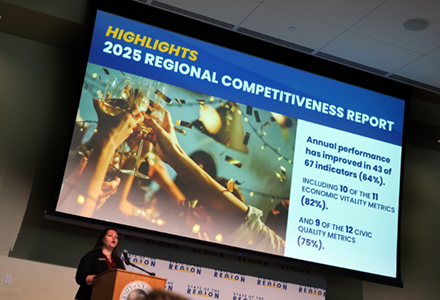
“The affordability improvements I presented are not evenly distributed. In fact,
the financial disparities appear to be widening,” said Sarah Burgoyne, the senior
director of research and public policy for the Tampa Bay Partnership.
Burgoyne said while she’s encouraged by the new data that shows positive signs, Tampa
Bay’s progress should support the economic vitality of all residents.
‘Market hotness’ cools
When it comes to trends in housing, child care and education costs, researchers revealed:
- Tampa Bay’s “market hotness” has cooled, with homes on the market from 10 to 11 weeks before being sold.
- The region lags in K-12 educational spending, with some regions investing 30-40% more per student than Tampa Bay
- First-generation student enrollment saw a significant drop, from 25% to 21%
While the area’s first-time in college enrollment rate has fluctuated widely over
the past decade, researchers remained positive about the future trend lines.
Manish Agrawal, a professor in USF’s School of Information Systems and Management, said statistics
such as the first-generation student enrollment rate indicate a region’s talent pipeline.
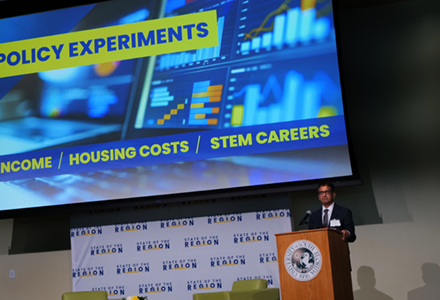
“We are beginning to see improvements and are optimistic about this indicator of upward
mobility for the coming years,” he said.
USF’s Shivendu Shivendu, an associate professor in the School of Information Systems and Management, presented
some econometric models showing how policy changes could move the needle in Tampa’s
competitiveness rank. For example, Shivendu suggested policy initiatives that would
reduce commute times by five minutes would drive the median household income up.
“To achieve this, we can improve public transportation infrastructure and increase
affordable housing near the urban core,” he said.
Celebrating regionalism
Nikky Flores, the board chair of the Tampa Bay Partnership, closed the luncheon by reminding attendees that while there were ‘big wins’ for the region in terms of improving metrics, the momentum highlights the opportunity to build more homegrown talent and the need to keep pushing for prosperity for all.
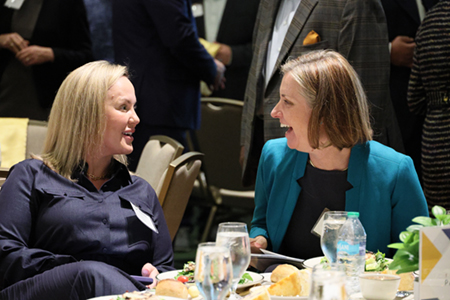
“Tampa Bay’s growth story is remarkable, placing us at a pivotal moment where we can
ensure the rising tide truly lifts all boats. However, we must remain attentive to
growing financial disparities because the accomplishments mean little if they are
not shared broadly,” she said.
“With your help, I know new partnerships can form, strategies can take shape, and
we can write Tampa Bay’s next chapter together,” she said.
For those interested in a deeper dive into the data, an online “Ask the Researchers”
session is set for 9 a.m. Feb. 20 where attendees can connect with the researchers
and ask questions about any particular areas of interest. To attend the session, register
here.
